#Great Comet of 1861
Text

English School - The Great Comet of 1861 as seen from Staines Bridge, Middlesex
761 notes
·
View notes
Text

The Great Comet of 1861, illustration for Bilderatlas der Sternenwelt (Picture Atlas of the Starry World) by Edmund Weiss (1888)
410 notes
·
View notes
Text


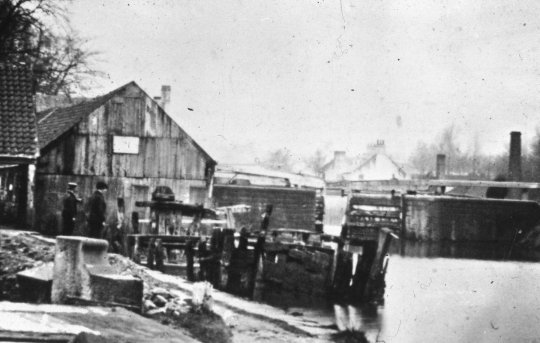

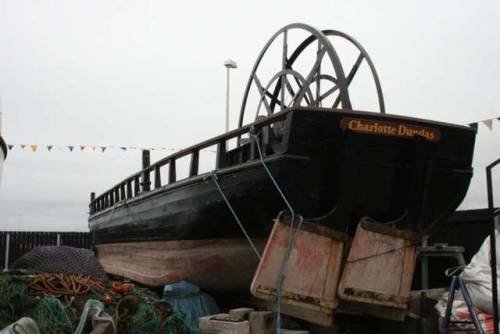
4th January 1803 saw the launch the steamboat, the “Charlotte Dundas”, designed by William Symington.
Charlotte Dundas is regarded as the world's second successful steamboat, the first towing steamboat and the boat that demonstrated the practicality of steam power for ships.
In June 1800, Lord Dundas got approval from the canal company’s directors for a boat to be built, powered by an engine designed by William Symington. The boat was built by Alexander Hart in his Grangemouth boatyard and the horizontal cylinder engine at the Carron Company.
In 1801, Symington patented a horizontal steam engine directly linked to a crank and gained the support of Lord Dundas for a second steamboat, the Charlotte Dundas, which was built in 1802 in Hart’s yard by John Allan. She measured 65ft long, 16ft wide and 8ft deep, it was named after the Lord’s daughter
On its maiden voyage, the Charlotte Dundas on this day in 1803, carried Lord Dundas and a few of his relatives and friends on board. .The twenty-mile trip took six hours, quite slow, yes, but the Charlotte Dundas was also hauling two seventy-ton barges, and it was doing so against strong head winds. In March 1803, the Charlotte Dundas towed two 70-ton barges 19 miles along the Forth and Clyde Canal to Glasgow, taking nine and a quarter hours and demonstrating the practicality of steam power for towing boats.
The Charlotte Dundas has gone down in history as the world’s first practical steam boat. She is famous worldwide as a forerunner of the great American river steamships and Henry Bell’s Comet, and has earned her rightful place in history. The vessel features on Grangemouth’s coat of arms and in many places around the town as well as in museums, on stamps and on coats of arms throughout the world.
Lord Dundas initially ordered eight more steamboats to be built. Then conservative forces rose up against a new (and hence fearful) technology. Opponents argued that the paddle wheel action would erode the canal banks. The enterprise finally collapsed. The Charlotte Dundas was broken up in 1861. Two piece of wood which are remnants of the wooden rudder from the Charlotte Dundas are part of Falkirk Community Trust collection.
The second pic is the wreck of Charlotte Dundas, at Tophill, Lock 10 of The Forth and Clyde Canal, Camelon, Falkirk, circa 1860. The others are a replica of the paddle steamer, which as far as I know is in a boatyard at Arbroath, there are occasional stories in the press saying there are plans to exhibit the 56ft long replica in Grangemouth, but so far it has not come to fruition, which is a shame as I think it sould be a real tourist atraction for the town.
You can find out more about the Charlotte Dundas, and a heritage trail where you can follow in the paddle waves of the historic steamboat http://charlottedundas.com/
12 notes
·
View notes
Photo
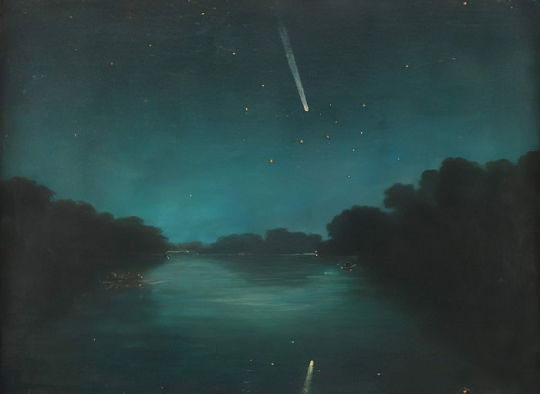
The Great Comet of 1861 as seen from Staines Bridge, Middlesex (oil on zinc) by English School
8 notes
·
View notes
Text
A thought about Sozin's comet:
In the show, Sozin's comet only appears for a few hours, maybe a full day at most. However, this is not how comets work on Earth. A comet the size and closeness of Sozin's would be visible for months as it passed around the sun: compare the Great Comet of 1680, which was visible from 14 November 1680 until 19 March 1681; the Great Comet of 1861 was visible from 13 May until mid-August. Comet Hale-Bopp currently holds the record at 18 months of visibility—May 1996 until December 1997. Halley's Comet, possibly the most famous, goes by quite a bit quicker, with visibility ranging from nearly a year (13 March – 25 December 1758) to only a few weeks (20 April – 20 May 1910) but that's still not over in a single day.
So what's going on?
Option One: comets just go by really fast on this world.
Option Two: The fight against Ozai and the Agni Kai against Azula took longer than it seems, making up several days if not weeks as the comet made its approach. Possibly the fights were extended because the comet gives firebenders so much power and strength that concerns like eating and sleeping became less vital.
Option Three: The fights didn't take that long; the post-comet finale is just several weeks later, once the comet has passed. They certainly would have needed time to get everyone out of prison and get them their new clothes and assemble an audience from the Water Tribes and Earth Kingdom for Zuko's coronation.
Option Four: combination of the above. Sozin's comet passes unusually quickly, lasting only about a month, which is in line with Halley's Comet. The fights take a few days, and the clean up takes longer. Zuko's coronation takes place after the comet has passed, a few weeks later.
6 notes
·
View notes
Text
Events 5.13
1373 – Julian of Norwich has visions of Jesus while suffering from a life-threatening illness, visions which are later described and interpreted in her book Revelations of Divine Love.
1501 – Amerigo Vespucci, this time under Portuguese flag, set sail for western lands.
1568 – Mary Queen of Scots is defeated at the Battle of Langside, part of the civil war between Queen Mary and the supporters of her son, James VI.
1612 – Sword duel between Miyamoto Musashi and Sasaki Kojiro on the shores of Ganryū Island. Kojiro dies at the end.
1619 – Dutch statesman Johan van Oldenbarnevelt is executed in The Hague after being convicted of treason.
1654 – A Venetian fleet under Admiral Cort Adeler breaks through a line of galleys and defeats the Turkish navy.
1779 – War of the Bavarian Succession: Russian and French mediators at the Congress of Teschen negotiate an end to the war. In the agreement Austria receives the part of its territory that was taken from it (the Innviertel).
1780 – The Cumberland Compact is signed by leaders of the settlers in the Cumberland River area of what would become the U.S. state of Tennessee, providing for democratic government and a formal system of justice.
1804 – Forces sent by Yusuf Karamanli of Tripoli to retake Derna from the Americans attack the city.
1830 – Ecuador gains its independence from Gran Colombia.
1846 – Mexican–American War: The United States declares war on the Federal Republic of Mexico following a dispute over the American annexation of the Republic of Texas and a Mexican military incursion.
1861 – American Civil War: Queen Victoria of the United Kingdom issues a "proclamation of neutrality" which recognizes the Confederacy as having belligerent rights.
1861 – The Great Comet of 1861 is discovered by John Tebbutt of Windsor, New South Wales, Australia.
1861 – Pakistan's (then a part of British India) first railway line opens, from Karachi to Kotri.
1862 – The USS Planter, a steamer and gunship, steals through Confederate lines and is passed to the Union, by a southern slave, Robert Smalls, who later was officially appointed as captain, becoming the first black man to command a United States ship.
1888 – With the passage of the Lei Áurea ("Golden Law"), the Empire of Brazil abolishes slavery.
1912 – The Royal Flying Corps, the forerunner of the Royal Air Force, is established in the United Kingdom.
1917 – Three children report the first apparition of Our Lady of Fátima in Fátima, Portugal.
1940 – World War II: Germany's conquest of France begins, as the German army crosses the Meuse. Winston Churchill makes his "blood, toil, tears, and sweat" speech to the House of Commons.
1941 – World War II: Yugoslav royal colonel Dragoljub Mihailović starts fighting against German occupation troops, beginning the Serbian resistance.
1943 – World War II: Operations Vulcan and Strike force the surrender of the last Axis troops in Tunisia.
1945 – World War II: Yevgeny Khaldei's photograph Raising a Flag over the Reichstag is published in Ogonyok magazine.
1948 – Arab–Israeli War: The Kfar Etzion massacre occurs, a day prior to the Israeli Declaration of Independence.
1950 – The inaugural Formula One World Championship race takes place at Silverstone Circuit. The race was won by Giuseppe Farina, who would go on to become the inaugural champion that year.
1951 – The 400th anniversary of the founding of the National University of San Marcos is commemorated by the opening of the first large-capacity stadium in Peru.
1952 – The Rajya Sabha, the upper house of the Parliament of India, holds its first sitting.
1954 – The anti-National Service Riots, by Chinese middle school students in Singapore, take place.
1958 – During a visit to Caracas, Venezuela, the US Vice President Richard Nixon's car is attacked by anti-American demonstrators.
1958 – May 1958 crisis: A group of French military officers lead a coup in Algiers demanding that a government of national unity be formed with Charles de Gaulle at its head in order to defend French control of Algeria.
1958 – Ben Carlin becomes the first (and only) person to circumnavigate the world by amphibious vehicle, having travelled over 17,000 kilometres (11,000 mi) by sea and 62,000 kilometres (39,000 mi) by land during a ten-year journey.
1960 – Hundreds of University of California, Berkeley students congregate for the first day of protest against a visit by the House Committee on Un-American Activities.
1967 – Dr. Zakir Husain becomes the third President of India. He is the first Muslim President of the Indian Union. He holds this position until August 24, 1969.
1969 – May 13 Incident involving sectarian violence in Kuala Lumpur, Malaysia.
1971 – Over 900 unarmed Bengali Hindus are murdered in the Demra massacre.
1972 – A fire occurs in the Sennichi Department Store in Osaka, Japan. Blocked exits and non-functional elevators result in 118 fatalities (many victims leaping to their deaths).
1972 – The Troubles: A car bombing outside a crowded pub in Belfast sparks a two-day gun battle involving the Provisional IRA, Ulster Volunteer Force and British Army. Seven people are killed and over 66 injured.
1980 – An F3 tornado hits Kalamazoo County, Michigan. President Jimmy Carter declares it a federal disaster area.
1981 – Mehmet Ali Ağca attempts to assassinate Pope John Paul II in St. Peter's Square in Rome. The Pope is rushed to the Agostino Gemelli University Polyclinic to undergo emergency surgery and survives.
1985 – Police bombed MOVE headquarters in Philadelphia, killing six adults and five children, and destroying the homes of 250 city residents.
1989 – Large groups of students occupy Tiananmen Square and begin a hunger strike.
1990 – The Dinamo–Red Star riot took place at Maksimir Stadium in Zagreb, Croatia between the Bad Blue Boys (fans of Dinamo Zagreb) and the Delije (fans of Red Star Belgrade).
1992 – Li Hongzhi gives the first public lecture on Falun Gong in Changchun, People's Republic of China.
1995 – Alison Hargreaves, a 33-year-old British mother, becomes the first woman to conquer Everest without oxygen or the help of sherpas.
1996 – Severe thunderstorms and a tornado in Bangladesh kill 600 people.
1998 – Race riots break out in Jakarta, Indonesia, where shops owned by Indonesians of Chinese descent are looted and women raped.
1998 – India carries out two nuclear weapon tests at Pokhran, following the three conducted on May 11. The United States and Japan impose economic sanctions on India.
2005 – Andijan uprising, Uzbekistan; Troops open fire on crowds of protestors after a prison break; at least 187 people were killed according to official estimates.
2006 – São Paulo violence: Rebellions occur in several prisons in Brazil.
2011 – Two bombs explode in the Charsadda District of Pakistan killing 98 people and wounding 140 others.
2012 – Forty-nine dismembered bodies are discovered by Mexican authorities on Mexican Federal Highway 40.
2013 – American physician Kermit Gosnell is found guilty in Pennsylvania of murdering three infants born alive during attempted abortions, involuntary manslaughter of a woman during an abortion procedure, and other charges.
2014 – An explosion at an underground coal mine in southwest Turkey kills 301 miners.
0 notes
Photo
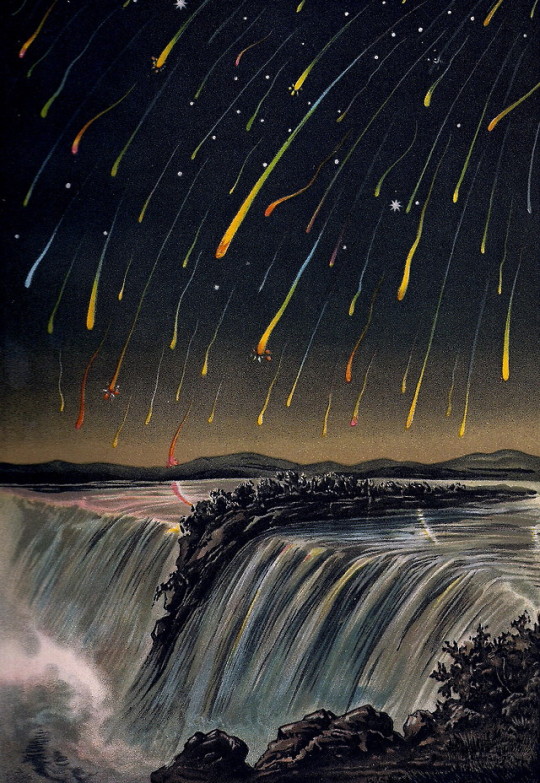

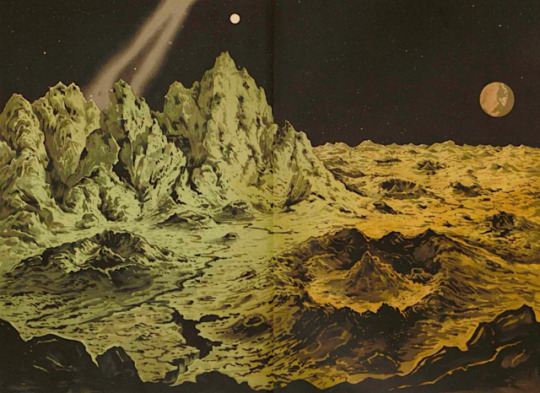
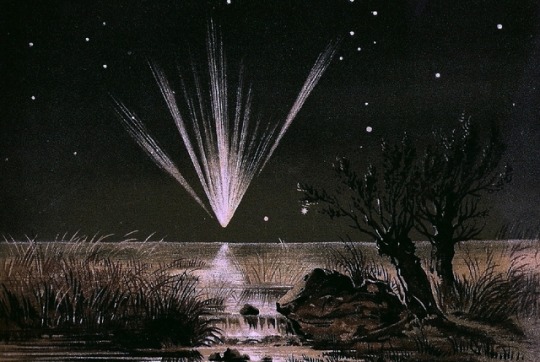
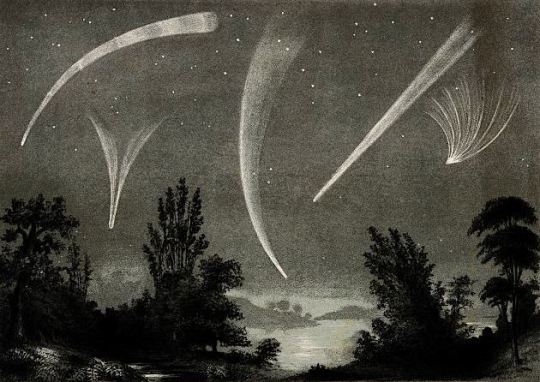
Edmund Weiss. Bilderatlas der Sternenwelt (Stellar Atlas). 1888-1892.
#Edmund Weiss#Edmund Weiß#1837-1917#Stellar Atlas#Starry messangers#Leonid Meteor Storm#1830#1861#1888#Tebbutt#C/1861 J1#comets#Meteors#Astronomical Phenomena#Bilderatlas der Sternenwelt#1892#mtr#Great Comet of 1861#C/1858 L1#Donati comet#Arcturus#magic transistor#the constellation Bootes#magictransistor#bright star near the comet's head#1858#Donati#Comet C/1858 L#astronomy#cosmology
10K notes
·
View notes
Photo


Supernatural, 5.16 “Dark Side of the Moon” / Great Comet of 1861, drawing by E. Weiss
44 notes
·
View notes
Text
“The gender segregation of nineteenth-century society reached deep into coeducational high schools. Students may have shared classes and competed for awards, but they were slow to lose their consciousness (if they ever did) that they belonged to two opposing corporate bodies, distinguished by culture and loyalty: the boys and the girls. Such distinctions were often made by teachers and administrators even in grammar schools.
One female letter writer to St. Nicholas noted a divided playground. (‘‘The cherry-trees are on our side, and I like it the best.’’) At Alice Blackwell’s neighborhood grammar school, girls and boys used different staircases (with demerits administered to violators). Jessie Wendover’s grammar school teacher ‘‘sent the girls down in the court to eat their dinner and gave the boys permission to talk and eat for twenty minutes.’’ The same kinds of arrangements in secondary schools allowed for separate girls’ and boys’ floors.
In the early days of Bridgton Academy in North Bridgton, Maine—and surely in many other schools as well—boys and girls sat on opposite sides of the room. Even where girls and boys intermingled freely in the classroom, though, they tended to be segregated in the free parts of the school day. The British observer Sara Burstall, who came to the United States in the 1890s to investigate the American education of girls, observed ‘‘no difference’’ between boys’ and girls’ conduct and freedom in the classroom.
But she noted, ‘‘out of class there seemed to be very little general intercourse—girls speaking to girls, and boys to boys. At recess the sexes are generally separated, the boys occupying the basement, and the girls the upper part of the buildings.’’ The Somerville, Massachusetts, student newspaper, observed, probably caustically, ‘‘We think that rail between the boys’ and girls’ side of the lunch room is quite an institution.’’
Where there were no such administrative separations, girls and boys often segregated themselves and participated in separate activities. Ellen Emerson loved the extraordinary Sanborn School, which she attended following Agassiz School in the late 1850s, in part because ‘‘boys and girls go together which I think is essential to a good school.’’ However, she went on, ‘‘They do not play together. I don’t think that could be done in this generation, but it will in the next, but the girls have at least the recreation of seeing the boys play, and it is a great one.’’
This wistful vision of girls watching boys play, sometimes football, sometimes leapfrog, suggests the distances which separated boys and girls even in this progressive midcentury private school run by the radical abolitionist Franklin Sanborn. And as Burstall reported, such separation did not end in the next generation. When a male classmate died in Jessie Wendover’s school in 1885, girls and boys separately sent flowers, the girls ‘‘in the form of a pillow,’’ the boys, ‘‘a broken pillar of flowers.’’
The same sense of distance between girls and boys was evident in Margaret Tileston’s discussion of interactions between the girls and boys in Salem High School, which still maintained separate classes for boys and girls. Tileston had several brothers, but within the context of her school experience, boys existed in Margaret Tileston’s diary (and in her view of the universe) as alien creatures. She noted a rare encounter that spring: ‘‘A boy sat in the room finishing his examination while we had our French. The girls stared at him as he came in as if he had been some strange animal.’’ Initially, even in coeducational schools, much divided girls and boys, who approached each other warily. In completely coeducational schools, the tone changed, though some divisions between the boys and girls seemed to hold up.
A boy’s description of corridor life in the Brookline, Massachusetts, Sagamore in 1896 noted an innovation in their new school building: ‘‘a roomy, pleasant, well-lighted gathering-place, where the whole school may meet on equal terms at recess.’’ The scene was raucous. The writer turned ‘‘his head just in time to escape a flying waste-basket, used as a foot-ball by some would-be members of next year’s team.’’ Boys with buns in their mouths and cups of chocolate in their hands from the lunch counter were playing leap-frog.
A curtain was lifted at the end of the hall, and a girls’ calisthenics class in ‘‘dainty slippered feet and bloomers’’ ran ‘‘the gauntlet, one after another, not altogether unwillingly,’’ the author concluded, encouraged by boys’ cheers. There was clearly a ‘‘boys’ side’’ and a ‘‘girls’ side.’’ ‘‘Teachers and girls, all eating their lunch and all talking at once, occupy the settees along the wall.’’ There was some fraternizing. ‘‘Several gallant fellows were entertaining groups of girls,’’ the author noted. But it took ‘‘gallantry’’ for boys to cross the line to the girls’ side, so clear, still, was the gender divide.
In fact, gender relations in the Victorian high school often crossed a highly charged field separating two opposing camps. Although a Victorian chivalry might govern official relations between ‘‘the young ladies’’ and other scholars, the open columns of school newspapers, bearing such titles as ‘‘Shavings’’ and ‘‘Scintillations,’’ allowed for ample sparring in an ongoing battle of the sexes. The intensity of that sparring suggests the extent to which coeducational high schools by their nature ended by challenging orthodoxies. Insults appeared in the earliest journals. The handwritten Winchester, Massachusetts, High School Offering of 1861, issued by two female editors, asked, ‘‘Why are the young gentlemen of this school like vessels plying between Boston and New York?’’ The answer: ‘‘Because they are coasters.’’
In 1879 the High School News of Great Falls, New Hampshire, published in two sections, with a ‘‘Supplement’’ from ‘‘The Young Ladies’ Department.’’ As befit their divided school and polarized presentation, the two sides found their best copy in each other. In their fifth issue in May 1879, ‘‘Vox Puellarum’’ (the voice of the girls) rallied her readers: ‘‘Girls, here it is again, a fling at us! can’t we retaliate? I propose ‘diamond cut diamond’ with such editors as ours!’’
Previously, she implied, the boys had made some cracks about the weaknesses of young ladies’ ‘‘anatomical construction.’’ ‘‘The following month . . . we present to them a Hero; again they retort with ‘Our Model Girl’ as if we (the H.S. girls) thought of nothing but promenades and spring styles.’’ Although the boys signed their pieces, such daring talk from young ladies required a pseudonym, and was signed with one. It was not until the 1890s that girls’ full and correct names accompanied their pieces.
Behind the reciprocal digs were some truths. Discipline fell most strenuously on male heads. (‘‘Poor young ladies! Too insignificant to be noticed!’’ commented one columnist on the apparent immunity of girls from punishment.) And boys often had to answer for girls’ relative accomplishments. An 1883 letter from a ‘‘former classmate’’ to the male editor of the Concord, New Hampshire, Comet observed, ‘‘Your success seems to be due in a great part to the literary ability of the fairer sex.’’ The letter writer went on: ‘‘It seems to be a peculiar fact . . . that women are born to rule, and, as in this case, to be among the first to start a paper which is open to the general criticism of the people.’’ The result was that some parries had undeniably violent subtexts.
In 1884, the year after the Comet editor heard of the accomplishments of ‘‘the fairer sex,’’ his successor ran an exchange item. Untitled, it was a first-person poem about the modern schoolgirl. The Comet ran it on the back page as filler. It bragged about schoolgirls’ appearance as ‘‘the handsomest girls of our race/ Superb in form and of exquisite face,’’ who ‘‘dress with perfect, consummate grace.’’ It then referred to their accomplishments, suggesting a critical lack: We know many tongues of living and dead,/In science and fiction we’re very well read:/But we cannot cook meat and cannot make bread,/And we’ve wished many times that we were all dead.
This verse took the common form of the assault on the New Woman, an attack on her lack of domestic accomplishments, managing to avoid fictive murder only by putting the action in the first person and arranging instead for a suicide wish. The compliment was returned in a poem published by the Comet’s successor, the Volunteer, in 1887. Under the title ‘‘Boys! Don’t Read This!’’ came an attack on the cigarette-smoking dandy.
Appealing to the nonreading boy with its sensational title, the poet asked To you who smoke the cigarette (I wonder if you’ve thought it)/Who made this little cigarette?/You only know you bought it./Perhaps some dark Italian,/Or Jew from foreign land,/Rolled up that little cigarette/With greasy, dirty hand. This nativist jab from the hinterlands on the new immigrant workforce was not the point of the poem, however, but only the vehicle to its ultimate pronouncement. But if boys will smoke cigarettes/Although the smoke may choke them,/One consolation still remains—/They kill the boys that smoke them.
Seeping through Victorian niceties, these death wishes illuminate only the obvious: that the gender challenges occurring in the nineteenth-century high school did not come without unleashing considerable unease as well as possibility. To understand the dynamics of this change, it makes sense to trace the action in a number of arenas. As we have seen, girls dominated the academic rankings in most high schools.
They made slower inroads in extracurricular activities, especially in the important male-gendered activities, debate, athletics, and military drill. The awarding of direct political power, in the election of class officers, remained surprisingly uncontested, with boys seemingly the only possibility for class president. The more substantial role of girls in student newspapers, however, was particularly important by virtue of the power this bestowed to influence school opinion.”
- Jane H. Hunter, “High School Culture: Gender and Generation.” in How Young Ladies Became Girls: The Victorian Origins of American Girlhood
7 notes
·
View notes
Text
Steam and Screw
The period 1815 to 1860 saw the beginng of the end of the age of wood and sail, and the transition to a battle fleet of iron, propelles by steam. The process was long- drawn out, and some false trails were followed, but by large the Navy embraced the new technology with enthusiasm. The Admiralty first used steam in 1816, when a steam tug was hired for towing trials. The first naval ship, a tug named Comet, was ordered in 1819. The first warships arrived 1828; they were paddle driven, which was a disadvantage in fighting ship because the machinery and paddles were vunerable, and the broaside was limited. A further disadvantage, which applied also to vessels propelled by a screw, was that the vibration of the machinery tended to shake wooden ships apart.

The Niger Expedition... off Holyhead... Aug-Oct 1841. HMS Albert also shows Sudan and Wiberforce, by Edward Duncan
The screw was first succesfully demonstrated at the same time as iron was introduced as shipbuilding material. The Royal Navy’s first iron warship was HMS Albert, a paddle gunboat ordered in 1840, but after 1845 the Navy ceased its iron shipbuilding programm while trials into the resistance of iron to shellfire were carried out, and means of overcoming the problems of fouling of iron hulls, so much worse than woth copper bottomed ships, were sought, as well as a means of correcting magnetic compasses on iron ships.

HMS London, launched 1840 was a two decker which was converted to screw propulsion.
In the meantime, purpose- designed wooden steam propelled battleships were built from 1847 onwards. They were screw propelled, because it was realised that the screw better propelling a ship, and that the disadvantages of vulnerability and limited gunpower did not apply. Masts and yards were retained because the steam machinery, though adequatley reliable, was very uneconomical.

French ironclad La Gloire, 1860
By the mid 1850s when the Crimean War showed that wooden ships could not resist the penetrative effects of shellfire, the problems of fouling, compasses, iron quality, and other minor matters were in a fair way to being resolved. So when the French built the wooden, armour plated, steam propelled Gloire in 1858, Great Britain was ready to usher in the modern battleship era with the Warrior and Black Prince, iron hulled, iron armoured and steam propelled : the first modern battleships.
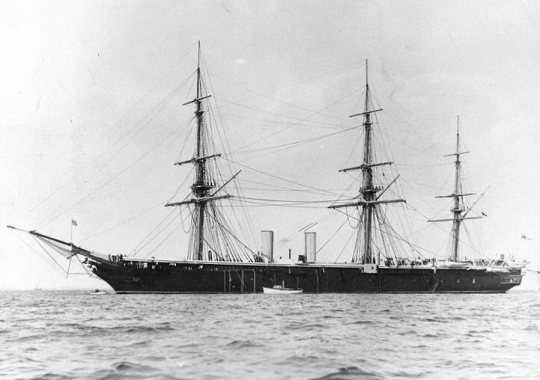
HMS Black Prince, launched 1861, photographed 1880

HMS Warrior, launched 1860, photographed 2009
67 notes
·
View notes
Photo

Base Image: Great Comet of 1861, also known as C/1861 J1 or comet Tebbutt; drawing by E. Weiss (via Wikimedia Commons)
#glitch#glitchart#glitchaesthetic#digitalart#newmediaart#art#artistsoninstagram#artist#artwork#artofinstagram#glitchartist#glitchywitchy#glitchywitchyart#abstractart#abstractartist#abstract#contemporaryart#contemporaryartist#contemporaryartwork#contemporaryartists#contemporary_art#newmedia#newmediaartist#newmediaartists#purple#pink#fuschia#yellow#peach#apricot
2 notes
·
View notes
Text
What’s Up - April 2018
What’s Up For April?
The Moon, Mars and Saturn and the Lyrid meteor shower!

The Moon, Mars and Saturn
The Moon, Mars and Saturn form a pretty triangle in early April, the Lyrid Meteors are visible in late April, peaking high overhead on the 22nd.
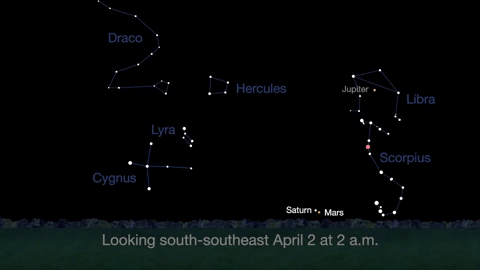
You won't want to miss red Mars and golden Saturn in the south-southeast morning skies this month. Mars shines a little brighter than last month.

By the 7th, the Moon joins the pair. From a dark sky you may see some glow from the nearby Milky Way.
Lyrid Meteors

Midmonth, start looking for Lyrid meteors, which are active from April 14 through the 30th. They peak on the 22nd.
The Lyrids are one of the oldest known meteor showers and have been observed for 2,700 years. The first recorded sighting of a Lyrid meteor shower goes back to 687 BC by the Chinese. The pieces of space debris that interact with our atmosphere to create the Lyrids originate from comet C/1861 G1 Thatcher. Comet Thatcher was discovered on 5 April 1861 by A. E. Thatcher.

In the early morning sky, a patient observer will see up to more than a dozen meteors per hour in this medium-strength shower, with 18 meteors per hour calculated for the peak. U.S. observers should see good rates on the nights before and after this peak.

A bright first quarter moon plays havoc with sky conditions, marring most of the typically faint Lyrid meteors. But Lyra will be high overhead after the moon sets at midnight, so that's the best time to look for Lyrids.
Jupiter & Juno
Jupiter will also be visible in the night sky this month!

Through a telescope, Jupiter's clouds belts and zones are easy to see.

And watch the Great Red Spot transit--or cross--the visible (Earth-facing) disk of Jupiter every 8 hours.

Our Juno spacecraft continues to orbit this gas giant, too!

And Juno's JunoCam citizen science team is creating exciting images of Jupiter's features based on the latest spacecraft data.
Next month Jupiter is at opposition--when it rises at sunset, sets at sunrise, and offers great views for several months!
Watch the full What’s Up for April Video:
youtube
There are so many sights to see in the sky. To stay informed, subscribe to our What’s Up video series on Facebook.
Make sure to follow us on Tumblr for your regular dose of space: http://nasa.tumblr.com.
#nasa#nasagif#jupiter#saturn#mars#lyrid#meteors#constellations#skywatching#astronomy#nightssky#upinthesky#whatsup#april#jpl
2K notes
·
View notes
Text
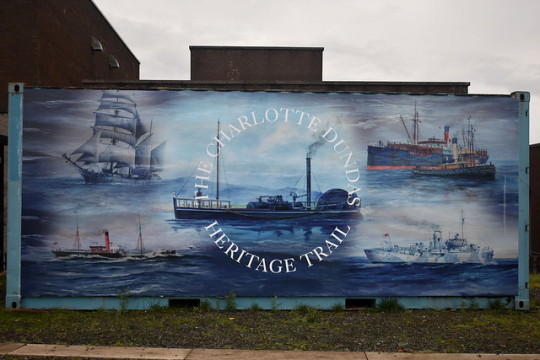


On January 4th 1803 the Charlotte Dundas steam boat had it's maiden voyage.
In June 1800, Lord Dundas got approval from the canal company’s directors for a boat to be built, powered by an engine designed by William Symington. The boat was built by Alexander Hart in his Grangemouth boatyard and the horizontal cylinder engine at the Carron Company.
In 1801, Symington patented a horizontal steam engine directly linked to a crank and gained the support of Lord Dundas for a second steamboat, the Charlotte Dundas, which was built in 1802 in Hart’s yard by John Allan. She measured 65ft long, 16ft wide and 8ft deep.
The Charlotte Dundas proved herself in a trial on the canal two months later on March 1803 by towing two barges weighing 130 tons, 18 ½ miles in 9 ¼ hours thereby demonstrating her practicality as a steam powered towing boat. The horizontal steam engine, patented by Symington using cutting edge technology of the day, was years ahead of its time.
The Charlotte Dundas has gone down in history as the world’s first practical steam boat. She is famous worldwide as a forerunner of the great American river steamships and Henry Bell’s Comet, and has earned her rightful place in history. The vessel features on Grangemouth’s coat of arms and in many places around the town as well as in museums, on stamps and on coats of arms throughout the world.
Plans to introduce boats on the Forth and Clyde canal were thwarted, largely by fears of erosion of the banks, and a project to build tug boats for the Bridgewater Canal had ended with the Duke of Bridgewater’s death a few days before the March trial. Charlotte Dundas was left in a backwater of the canal at Bainsford until it was broken up in 1861.
Symington was not paid all he had invested in construction of Charlotte Dundas and was left disappointed, but the development of steamboats was continued by others including Robert Fulton in the United States and Henry Bell in Scotland. There is a replica of the boat lying in an Arbroath shipyard.
7 notes
·
View notes
Photo

Great Comet of 1861, also known as C/1861 J1 or comet Tebbutt; drawing by E. Weiss
12K notes
·
View notes
Text
Events 3.3
473 – Gundobad (nephew of Ricimer) nominates Glycerius as emperor of the Western Roman Empire.
724 – Empress Genshō abdicates the throne in favor of her nephew Shōmu who becomes emperor of Japan.
1575 – Mughal Emperor Akbar defeats Sultan of Bengal Daud Khan Karrani's army at the Battle of Tukaroi.
1585 – The Olympic Theatre, designed by Andrea Palladio, is inaugurated in Vicenza.
1776 – American Revolutionary War: The first amphibious landing of the United States Marine Corps begins the Battle of Nassau.
1779 – American Revolutionary War: The Continental Army is routed at the Battle of Brier Creek near Savannah, Georgia.
1799 – The Russo-Ottoman siege of Corfu ends with the surrender of the French garrison.
1820 – The U.S. Congress passes the Missouri Compromise.
1845 – Florida is admitted as the 27th U.S. state.
1849 – The Territory of Minnesota is created.
1857 – Second Opium War: France and the United Kingdom declare war on China.
1859 – The two-day Great Slave Auction, the largest such auction in United States history, concludes.
1861 – Alexander II of Russia signs the Emancipation Manifesto, freeing serfs.
1873 – Censorship in the United States: The U.S. Congress enacts the Comstock Law, making it illegal to send any "obscene literature and articles of immoral use" through the mail.
1875 – The first ever organized indoor game of ice hockey is played in Montreal, Quebec, Canada as recorded in the Montreal Gazette.
1878 – The Russo-Turkish War ends with Bulgaria regaining its independence from the Ottoman Empire according to the Treaty of San Stefano.
1891 – Shoshone National Forest is established as the first national forest in the US and world.
1910 – Rockefeller Foundation: John D. Rockefeller Jr. announces his retirement from managing his businesses so that he can devote all his time to philanthropy.
1913 – Thousands of women march in the Woman Suffrage Procession in Washington, D.C.
1918 – Russia signs the Treaty of Brest-Litovsk, agreeing to withdraw from World War I, and conceding German control of the Baltic States, Belarus and Ukraine. It also conceded Turkish control of Ardahan, Kars and Batumi.
1924 – The 407-year-old Islamic caliphate is abolished, when Caliph Abdülmecid II of the Ottoman Caliphate is deposed. The last remnant of the old regime gives way to the reformed Turkey of Kemal Atatürk.
1924 – The Free State of Fiume is annexed by the Kingdom of Italy.
1931 – The United States adopts The Star-Spangled Banner as its national anthem.
1938 – Oil is discovered in Saudi Arabia.
1939 – In Bombay, Mohandas Gandhi begins a hunger strike in protest at the autocratic rule in British India.
1940 – Five people are killed in an arson attack on the offices of the communist newspaper Flamman in Luleå, Sweden.
1942 – World War II: Ten Japanese warplanes raid Broome, Western Australia, killing more than 100 people.
1943 – World War II: In London, 173 people are killed in a crush while trying to enter an air-raid shelter at Bethnal Green tube station.
1944 – The Order of Nakhimov and Order of Ushakov are instituted in USSR as the highest naval awards.
1944 – A freight train carrying stowaway passengers stalls in a tunnel shortly after departing from Balvano, Basilicata, Italy just after midnight, with 517 dying from carbon monoxide poisoning.
1945 – World War II: In poor visibility, the RAF mistakenly bombs the Bezuidenhout area of The Hague, Netherlands, killing 511 people.
1953 – A De Havilland Comet (Canadian Pacific Air Lines) crashes in Karachi, Pakistan, killing 11.
1958 – Nuri al-Said becomes Prime Minister of Iraq for the eighth time.
1969 – Apollo program: NASA launches Apollo 9 to test the lunar module.
1972 – Mohawk Airlines Flight 405 crashes as a result of a control malfunction and insufficient training in emergency procedures.
1974 – Turkish Airlines Flight 981 crashes at Ermenonville near Paris, France killing all 346 aboard.
1980 – The USS Nautilus is decommissioned and stricken from the Naval Vessel Register.
1985 – Arthur Scargill declares that the National Union of Mineworkers' national executive voted to end the longest-running industrial dispute in Great Britain without any peace deal over pit closures.
1985 – A magnitude 8.3 earthquake strikes the Valparaíso Region of Chile, killing 177 and leaving nearly a million people homeless.
1986 – The Australia Act 1986 commences, causing Australia to become fully independent from the United Kingdom.
1991 – An amateur video captures the beating of Rodney King by Los Angeles police officers.
1991 – United Airlines Flight 585 crashes on its final approach to Colorado Springs killing everyone on board.
2005 – James Roszko murders four Royal Canadian Mounted Police constables during a drug bust at his property in Rochfort Bridge, Alberta, then commits suicide. This is the deadliest peace-time incident for the RCMP since 1885 and the North-West Rebellion.
2005 – Steve Fossett becomes the first person to fly an airplane non-stop around the world solo without refueling.
2005 – Margaret Wilson is elected as Speaker of the New Zealand House of Representatives, beginning a period lasting until August 23, 2006, where all the highest political offices (including Elizabeth II as Head of State), were occupied by women, making New Zealand the first country for this to occur.
2013 – A bomb blast in Karachi, Pakistan, kills at least 45 people and injured 180 others in a predominantly Shia Muslim area.
2017 – The Nintendo Switch releases worldwide.
1 note
·
View note
Photo

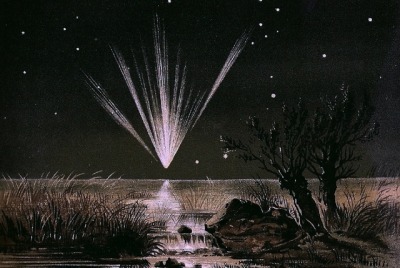






inspiration for poster assessment
fig. 1 A flock of cats fell by Ikegami Yoriyuki, 2017
fig. 2 Great Comet of 1861, also known as C/1861 J1 or comet Tebbutt; drawing by E. Weiss
fig. 3 A Moonlight Fantasy by Hilda Hechle, 1930
fig. 4 The Annunciation by Fra Angelico. Detail. 1430 - 1432
fig. 5 Illustrations by Charles Robinson for King Longbeard; Or, Annals of the Golden Dreamland by Barrington MacGregor (1898)
fig. 6 Hieronymus Bosch - Scenes from the Passion of Christ, Reverse of Painting “Saint John the Evangelist”. 1489
fig. 7 Remedios Varo, Celestial Pabulum (detail), 1958
fig. 8 Karl Friedrich Schinkel 1816 Stage Designs for Wolfgang Amadeus Mozart’s The Magic Flute.
5 notes
·
View notes